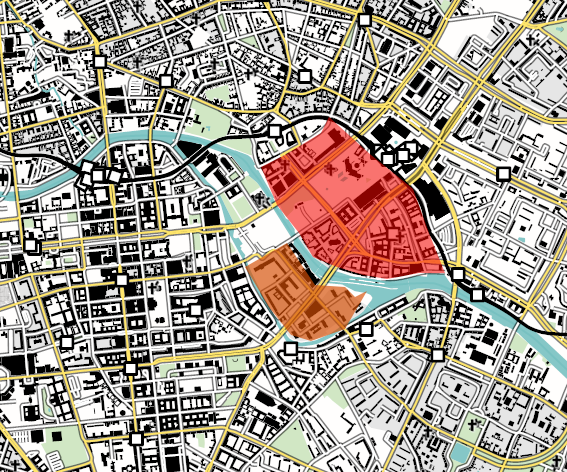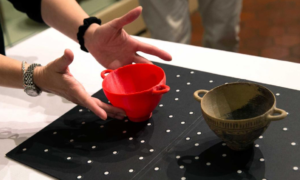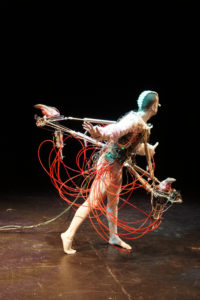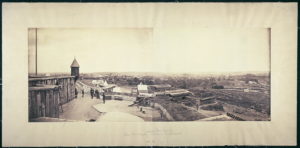Digital Humanities and Related Courses
Past Course Offerings
The Digital Flâneur: Mapping Twentieth-Century Berlin

GER 8205, German, Russian, and Eastern European Studies | Anderson/Calico
SP 2018: TR 1:10 – 2:25
Taught by Clifford Anderson, Associate University Librarian for Research and Learning and Professor of Religious Studies, and Joy Calico, Cornelius Vanderbilt Professor of Musicology, with Lindsey Fox, Coordinator of Geographic Information Systems.
This seminar explores the cultural history of Berlin in the twentieth century using theories and tools of the digital humanities. We examine the culture and geopolitics of twentieth-century Berlin from auditory and spatial perspectives, taking Walter Benjamin’s notion of the flâneur as our guide. The flâneur has long been a favorite emblem of urban modernity but it is also ripe for critique, as the freedom to wander a European cityscape at will has never been equally available to all. We engage classic texts about the city (Döblin, Roth, Simmel) and current scholarship on several topics (the Berlin Wall, urban planning, green spaces, migrant experience, queer Berlin, music, sport) to understand multiple ways of being and moving in that city at different moments in the twentieth century. We also work with questions and tools of the digital humanities based on the premise of Todd Presner’s HyperCities, “a collaborative research and educational platform for traveling back in time to explore the historical layers of city spaces in an interactive, hypermedia environment.” As flâneurs in the world of digital humanities, students will peruse multiple digital tools (such as Atom, CityGML, Cloudant, GitHub, Mapbox, GeoJSON, QGIS, Neo4J and Wikidata) over the course of the semester, examining what they represent and exclude. Students work on projects in time travel, curating tours of Berlin built on historical maps since 1900 featuring still and moving images, audio, historical documents, and prose. As an exercise in digital public humanities, students’ projects will be featured on a public website.
This course is open to undergraduates as well as graduate students outside the home department. This course does not fulfill requirements for undergraduate majors in German.
Exhibiting Historical Art: Digital Approaches to Ancient Greek Ceramics
SP 2018: T, 1.10-3.40 PM | Ikeshoji-Orlati
Taught by Veronica Ikeshoji-Orlati, CLIR Postdoctoral Fellow
 In this course, students will compose a new exhibition of the ancient Greek artefacts from the permanent collection of the Vanderbilt University Fine Arts Gallery. Students will learn about the history of ancient Greek pottery and apply a selection of digital humanities approaches – including 3D modelling and printing, virtual and augmented reality, and network and spatial analysis – to objects from the Gallery. The exhibition will recontextualize the ancient Greek artefacts for Gallery visitors and showcase students’ critical engagement with contemporary methods of art historical and archaeological analysis. This course will count as an Advanced Seminar, or as an Ancient, or as an Elective for the History of Art Major and Minor. AXLE: HCA.
In this course, students will compose a new exhibition of the ancient Greek artefacts from the permanent collection of the Vanderbilt University Fine Arts Gallery. Students will learn about the history of ancient Greek pottery and apply a selection of digital humanities approaches – including 3D modelling and printing, virtual and augmented reality, and network and spatial analysis – to objects from the Gallery. The exhibition will recontextualize the ancient Greek artefacts for Gallery visitors and showcase students’ critical engagement with contemporary methods of art historical and archaeological analysis. This course will count as an Advanced Seminar, or as an Ancient, or as an Elective for the History of Art Major and Minor. AXLE: HCA.
The Space between 1s and 0s: Digital Media and the Posthuman Vision
ENGL 3726 , English
MWF 11:10am-12:00pm | Shin
Taught by Haerin Shin, English and Cinema and Media Arts
“Lulled into somnolence by five hundred years of print, literary analysis should awaken to the importance of media-specific analysis, a mode of critical attention which recognizes that all texts are instantiated and that the nature of the medium in which they are instantiated matters.” ― N. Katherine Hayles

As breakthroughs in medical and computer science continuously expand the scope of our bodily and mental presence, the question concerning technology – the role it plays in defining our being and reality, its functional mechanism, and the effects such new methods of mediation exert upon our perception and cognition – presses us with an ever-growing urgency. How do we define and know who we are, and how does one certify his or her own existence, in an age when mechanical augmentation, extension, or even replacement of the body is a realistic venture, and the properties of the human mind can be reproduced, preserved, and/or emulated in the form of digital code? If the human body and its operational constitution could be compatible with that of machines, and self-evolving machines could interact with or even replace humans in their intellectual capacity, what does being human and discerning the grounds of the reality we inhabit involve, and mean? Do new mediatory means reconfigure the way in which we perceive, comprehend, and in turn build the world we live in? This course explores how new media represent, reflect on, and inspire ontological discourses by focusing on the structure and workings of digital and other types of telepresence technology. Students will examine how presence and its representation have transitioned from analog to digital, and organic to mechanic channels of mediation and instantiation. Course materials and exercises will, include reading/writing/interfaces in print (static) and digitally networked media, ranging from twitter fiction, film (digital/CGI), animation (cell/digital), videogame, comics (digital/web), and television show by authors/directors/artists such as Philip K Dick, Ted Chiang, Jennifer Egan, Oshii Mamoru, and Neal Stephenson. The primary texts and varied activities, including field trips and guest lecture, will be paired with critical/theoretical readings.
Virtual Identities, Digital Humanities

CMA 3892-02, Cinema and Media Arts
SP 2018: TR 11:00-12:15 | Casad
Taught by Madeleine Casad, Cinema and Media Arts and Associate Director, Center for Digital Humanities
This course begins with the premise that media profoundly shape our sense of identity and belonging in the world, and investigates the question of how new media technologies lead us to experience and express identity in new ways. Participants will examine artistic experiments with a range of media technologies, including cinema, digital animation, hypertext literature, digital archives, social media, augmented reality, and more. Discussions will trace themes of selfhood, individuality, social identity, resistance to marginalization, political critique and engagement. Readings for the course will draw on media, gender, and critical race studies and theories of selfhood and community in the digital age.
Students in the course will also take part in several workshops on digital tools for scholarly expression and argument, in preparation for a multimedia seminar project due at the end of the class.
Historic Black Nashville
UNIV 2655, University Course
Taught by Professors Jane Landers and Dan Sharfstein, History and Law

This interdisciplinary course will explore the under-developed history of black Nashville, from settlement to the early twentieth century, challenging some of the traditional narratives of black history and of Nashville. Using local archival collections, public history sites and infrastructure, it will introduce students to a variety of research methods and sources for uncovering Nashville’s black history. Given the impressive local plantations such as The Hermitage, Belle Meade, Carnton, and Grassmere, for example, many might consider Nashville a “typical” antebellum Southern locale. While this course will explore the histories of African Americans who lived on plantation sites (and their links to free people of color living in Nashville), it will also focus attention on Nashville’s significance as a river port city, connected to other similar ports from Canada to New Orleans, and, thus, privy to national and international information streams many other plantation areas were not. African Americans, free and enslaved, built and labored in Nashville and created a diverse black community that even before the Civil War owned businesses, organized churches, and supported schools for its children. African Americans who lived in Nashville also followed and took part in surprising range of foreign engagements in the nineteenth century, predating their better-known involvement in the U.S. Civil War.

After abolition, institutions like Central Tennessee College, Fisk, and Meharry offered higher education to the newly freed, and a short-lived newspaper, The Colored Tennessean (1865-66) contributed to that effort. Other African Americans, including a group Montgomery Bell had claimed as slaves, joined colonization projects in Sierra Leone and Liberia. As the Tennessee legislature moved to codify racial segregation after Reconstruction, African Americans in Nashville pushed back in a variety of ways, including a legislative lobbying campaign, editorials in black-owned newspapers such as the Nashville Clarion and the Nashville Globe, an organized streetcar boycott in 1905, and the incorporation of black transportation companies. During the epidemic of lynchings across the South in the late nineteenth and early twentieth centuries—which included four murders in Davidson County—black Nashvilleans organized to protest, raise local and national awareness, and resist. Black Nashvilleans gained voting rights earlier in the twentieth century than the vast majority of African Americans in the South, and the community’s economic and political strength provided a crucial regional foundation for the civil rights activism of the second half of the twentieth century.
This is an immersive undergraduate course that will involve lectures, site visits and independent student research. The course objective is to research and document previously neglected historical subjects and sites for Black Nashville relating to slavery, emancipation and Reconstruction, and the Jim Crow Era. The objective is to make that research available to the community that could guide residents and visitors through the now invisible black history of our city.
Each participant will write a 15-20 page research paper, based on original research in primary documents and secondary literature on the historical site, figure or event of your choosing. The research paper will be accompanied by a plan or design for a public history project (e.g., an exhibit, website, app, mapping project, historical markers) to make the research accessible to the public.